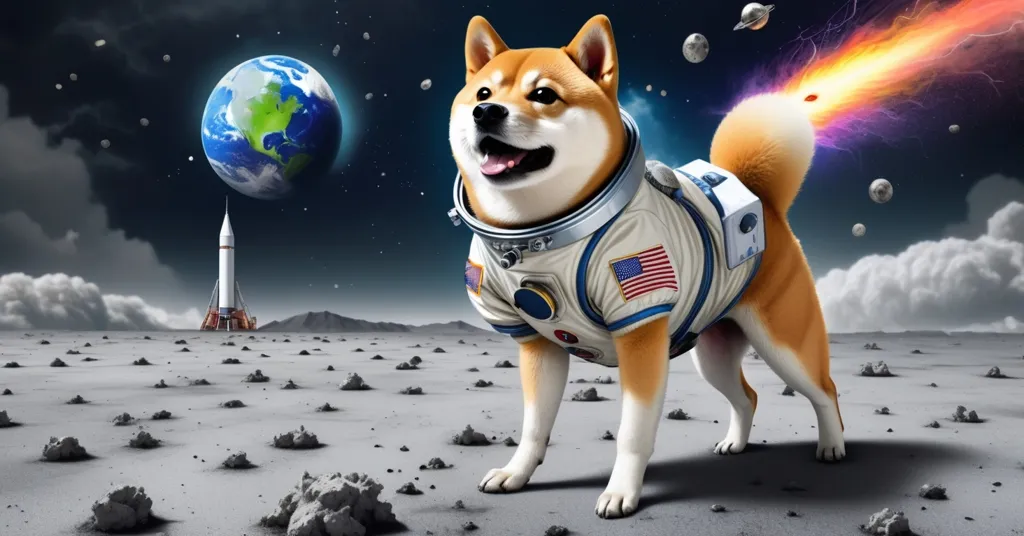Elon Musk Sparks Dogecoin Frenzy: Can DOGE-1 Hype Survive Crypto Crash?

Elon Musk Ignites Dogecoin Mania—But Can the Hype Defy a Brutal Market?
Elon Musk has once again whipped the crypto world into a frenzy with a cryptic X post saying, “It’s time,” sending Dogecoin (DOGE) fans into overdrive. While the original meme coin barely twitched, a related token, DOGE-1, exploded with a 300% surge before crashing hard, all while a mysterious whale scooped up millions in tokens. Yet, with the broader crypto market bleeding out, is there any real fuel left in this hype engine?
- Musk’s Magic Words: A vague “It’s time” post on X sparks Dogecoin speculation.
- DOGE-1’s Wild Ride: Spin-off token tied to a lunar mission surges 300%, then corrects.
- Market Bloodbath: Crypto downturn and macro fears crush risk appetite for meme coins.
Musk dropped his latest bombshell on November 5, replying to a Dogecoin community member on X with just two words: “It’s time.” For a coin that’s been a cultural juggernaut since its joke origins in 2013, this was like tossing a match into a room full of dynamite. Back in 2021, Musk’s tweets—calling DOGE “the people’s crypto”—propelled its market cap past $80 billion, with single posts spiking the price by double digits overnight. His appearance on Saturday Night Live that year, hyping Dogecoin as a “hustle,” sent it soaring before a predictable dump. Fast forward to today, though, and the Shiba Inu coin barely blinked, trading near $0.16 before slipping further as Bitcoin itself tanked 10% in a single day. The real fireworks happened with DOGE-1, a lesser-known token tied to a literal space mission, which shot up before dropping 17.4% to $0.73. Meanwhile, on-chain data revealed a big player, known as god.sol (or Mitch), quietly amassing 16.27 million DOGE-1 tokens for roughly $14,800 worth of SOL. What’s really going on here?
For those new to the game, Dogecoin is the granddaddy of meme coins, born as a satire of the crypto boom with a goofy dog mascot. It’s since become a symbol of rebellion against traditional finance, a way for the little guy to stick it to Wall Street with a smirk. Musk has been its loudest cheerleader, turning random tweets into market-moving events, as seen in the latest Dogecoin hype frenzy. But the crypto landscape isn’t the lawless playground of three years ago. Economic challenges, like rising interest rates and tough talk from the Federal Reserve signaling tighter money policies, have spooked investors away from risky assets like meme coins. Traders are fleeing to safer ground—think Bitcoin or Ethereum—leaving speculative plays like DOGE exposed to brutal volatility. It’s no surprise the “Musk effect” didn’t stick this time; with thin market liquidity (meaning not enough buyers and sellers to stabilize prices), even a billionaire’s quip can’t stop a freefall.
“It’s time” – Elon Musk, reigniting Dogecoin speculation with a cryptic X post on November 5.
“No Highs, No Lows, Only DOGE” – DogeDesigner (@cb_doge), echoing Musk’s 2021 lunar promise for Dogecoin on X.
Now, let’s zoom in on DOGE-1, the unexpected star of this saga. Unlike most meme tokens, which are pure digital speculation, DOGE-1 is linked to a tangible project—a CubeSat mission funded entirely in Dogecoin, developed by Geometric Energy Corporation. For the unversed, a CubeSat is a miniature satellite, often just a few inches across, used for research or low-cost space exploration. This one, slated for a late 2025 launch on a SpaceX Falcon 9 rocket, aims to collect lunar data, though specifics on its payload or scientific goals remain frustratingly vague. First announced years ago, the mission has faced repeated delays, originally targeting much earlier dates, which fuels skepticism about whether it’s a genuine endeavor or a marketing gimmick draped in crypto buzz. Musk’s 2021 vow to “put a literal Dogecoin on the literal moon” still lingers as the project’s rallying cry, but with each postponement, faith wanes. Still, the narrative proved potent enough to send the DOGE-1 token into orbit after Musk’s post, with speculators piling in for a quick buck before the inevitable crash-landing.
Adding intrigue, blockchain analytics from platforms like Lookonchain uncovered a savvy player in the mix. The pseudonymous trader god.sol, with a track record of $2.8 million in realized profits from meme coin flips, dropped about 100 SOL (around $14,800) to grab a hefty 16.27 million DOGE-1 tokens. This isn’t a casual dabbler—god.sol is known for rapid trades, rarely holding positions long, which suggests they’re betting on a fast exit before liquidity dries up. On-chain data, for those unfamiliar, refers to publicly visible transactions on a blockchain, allowing anyone to track wallet movements and spot whale activity (large investors who can sway markets). Moves like this highlight how meme coin trading often resembles a high-stakes game of musical chairs—everyone’s dancing until the music stops, and retail investors are usually left standing.
The broader crypto market context only darkens the picture. Early November has been a massacre, with Bitcoin’s 10% drop mirroring a wider sell-off. The total crypto market cap shed billions in days, driven by mass liquidations (forced sales of leveraged positions) and a collapse in risk appetite. Sentiment trackers, like the Fear and Greed Index, have swung hard into “fear” territory, reflecting trader caution. Global economic uncertainty—think geopolitical tensions and central bank policies tightening wallets—has pushed capital toward larger-cap tokens with more stability. Meme coins, lacking intrinsic value and driven purely by social media buzz, are the first to get slaughtered in this environment. Even Musk, the meme lord himself, can’t override a hawkish Fed or a recession scare with a tweet.
Let’s cut through the noise and unpack the risks of meme coins for a moment. These tokens, including Dogecoin and its offshoots like DOGE-1, often have no fundamental worth—they’re not backed by tech like Ethereum’s smart contracts or Bitcoin’s scarcity model. Their value hinges on hype, community fervor, and the occasional celebrity nod. That makes them prime targets for pump-and-dump schemes, where whales or insiders inflate prices before cashing out, leaving latecomers with worthless bags. Low liquidity exacerbates this; with few buyers in a downturn, selling even a small position can tank the price. And let’s not forget scams—fake tokens mimicking DOGE-1 or phishing schemes exploiting Musk’s name pop up faster than you can say “rug pull.” If you’re tempted by a 300% spike, check official project channels and wallet addresses before diving in. This space is a jungle, and naivety is lunch.
That said, it’s not all doom and gloom for meme coins. Dogecoin’s rabid community and branding have carved out a niche—think online tipping or microtransactions—bringing newbies into crypto who might never touch Bitcoin. They embody a punk ethos of financial freedom we champion, mocking the suits while onboarding the masses. Even DOGE-1, delays aside, hints at crypto funding real-world innovation, a proof-of-concept for decentralized money beyond speculation. But let’s be real: these are side shows. Bitcoin remains the bedrock of this revolution—scarce, secure, censorship-resistant. Meme coin chaos is a distraction from building a world where money isn’t controlled by central banks or bureaucrats.
So, what does this Musk-driven moment mean for our community of Bitcoin diehards, altcoin tinkerers, and decentralization warriors? Here’s a breakdown of the key questions and takeaways:
- What sparked the latest Dogecoin frenzy?
Elon Musk’s “It’s time” post on X on November 5 lit up the Dogecoin community, though DOGE itself barely moved while the DOGE-1 token surged 300% before correcting. - Why didn’t Dogecoin’s price skyrocket this time?
A savage crypto market downturn, with Bitcoin falling 10% and economic fears tied to Federal Reserve policies, has crushed enthusiasm for risky assets like meme coins. - What is DOGE-1, and is the project credible?
DOGE-1 is a meme token linked to a Dogecoin-funded CubeSat mission by Geometric Energy Corporation, aiming for a 2025 SpaceX launch to collect lunar data—though repeated delays raise doubts about execution. - Who is god.sol, and why are they significant?
A pseudonymous meme coin trader with $2.8 million in past profits, god.sol bought 16.27 million DOGE-1 tokens, showing how whale activity tracked via on-chain data fuels speculative spikes. - Is chasing meme coin pumps like DOGE-1 worth it?
Likely not—these are volatile gambles with thin liquidity, where big players often dump holdings before retail investors can react, leading to heavy losses. - How does Dogecoin fit into the crypto revolution?
It plays a niche role in community engagement and onboarding new users via humor and low stakes, but lacks the fundamentals of Bitcoin as a long-term store of value. - What should crypto enthusiasts watch for now?
Keep an eye on market liquidity for meme tokens, on-chain whale moves, DOGE-1 mission updates, and broader economic signals that could further impact risk sentiment.
Stepping back, Musk’s outsized role in crypto is both a blessing and a curse. His tweets keep the space lively, drawing eyeballs and capital, but they also amplify the casino vibes that turn off serious adopters. Historically, his influence has waned—compare the 2021 DOGE mania, where Tesla briefly accepting the coin sent prices parabolic, to today’s tepid response. It’s a sign the market is maturing, or at least getting jaded. DOGE-1’s lunar dream could be a neat milestone if it ever launches, proving crypto’s utility beyond digital gold or smart contracts. But with details scarce and delays piling up, it’s hard to bet on anything beyond a clever story. Could this model—crowdfunding real projects with meme coins—inspire more innovation? Maybe, but only if execution matches the hype.
Ultimately, we’re rooting for Bitcoin to anchor this financial uprising, with altcoins and meme tokens like Dogecoin playing their quirky parts. Musk’s antics are a sideshow, entertaining until they’re not. DOGE-1’s rollercoaster is a stark reminder: hype burns bright but fades fast, especially in a market this battered. Fundamentals always catch up, whether it’s Bitcoin’s unassailable network or a meme coin’s empty promises. Stay sharp, stack those sats, and don’t get caught holding the bag when the lunar landing turns into a crater.



